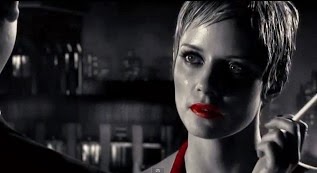Frank Miller and Robert Rodriguez's 2005 film Sin City is a hybrid, combining film noir, comic book and horror. It is a post modern text, combining film noir genre conventions such as the use of shadows, mistrust and paranoia, combined with comic book classic conventions, including the Propp character roles, of a hero and villain (s).
Analysis 1:
In the opening scene, a man and a woman are shown standing on a rooftop in Sin City. The woman character is represented as a femme fatale, which is a classic character role in film noir. She is wearing a long red dress, red lipstick, and is seen smoking. The colour connotations show danger and passion, which is characteristic of a femme fatale, in addition to being beautiful and untrustworthy. Her red dress stands out against the black and white background, showing she has some importance. The female character walks to the end of the balcony, with a high camera angle, showing her power and authority. This angle also immediately gives the viewer an establishing shot of the urban environment location. The non-diegetic sound of sirens also gives us an idea of the crime in the city, which is also supported by the title of the film, Sin City.
The non-diegetic music of the scene emulates Jazz music, which is a common convention in film noir, as the original film noir films were made at a time where Jazz music was very popular, around the 1940's, Creating a romantic feel between the pair, over the diegetic sound of the characters speech. The male character is first to speak, with non-diegetic speech, giving us an insight into his personal thoughts. Voice overs are a common convention of the film noir genre, and are used to demonstrate the protagonist character's thoughts, views and personality. The self narration allows the viewer to hear things which the other characters are unaware of, giving the viewer a more personal knowledge and more information. When the male character shoots the female character, the film breaks away from the typical femme fatale character, this combines the usual narrative convention, and provides genre differences.
The scene ends with dramatic rain, both visually and in sound. The rain only begins just as the male character is about to kill the female character. This is pathetic fallacy, and a common convention of the comic book genre.
Analysis 2:
This scene features Marv killing Kevin, and contains many conventions of the horror genre, including blood, low key lighting, weapons and emphasised sound.
Marv is wearing a trench coat in this scene, which is a convention of film noir. Trench coats were often worn by protagonists in film noir, as they were some form of detective or private eye, giving an element of mystery. Marv removes his trench coat just before he kills Kevin, which is a convention of the comic book genre, as it acts as a long flowing cape, showing him to be a hero, however he removes his metaphorical cape, as he knows that he is about to do wrong, and is not being a classic hero.
The low key lighting covers Kevin's face, hiding his facial features. This is a convention of the horror genre, hiding his identity, creating tension and giving the audience a sense of unease. Kevin's eyes are an icey blue colour, which are originally the only aspect of his face clear to the viewer. His face is then shown in colour properly, perhaps showing that his power is decreasing and his identity has been discovered. Kevin's slick movements and long nails suggest animalistic behaviour.
Marv tortures Kevin by removing his limbs, and then feeding his remains to Kevin's dog. This is part of the comic book genre as Kevin does not make any noise and keeps the same facial expression throughout (blank), which is very unrealistic. The fight scene is also comic book, as the sound of the movements are very exaggerated, and the characters appear unphased by the violence, showing Marv's superhuman strength.
Conclusion:
Overall, the three genres (film noir, comic book and horror) of the film show their genre contentions through the mise-en-scene, similar traits of the same genres, and the technical aspects. All of these factors show that the film is a hybrid of these genres.




No comments:
Post a Comment